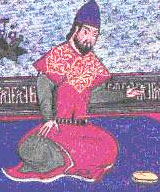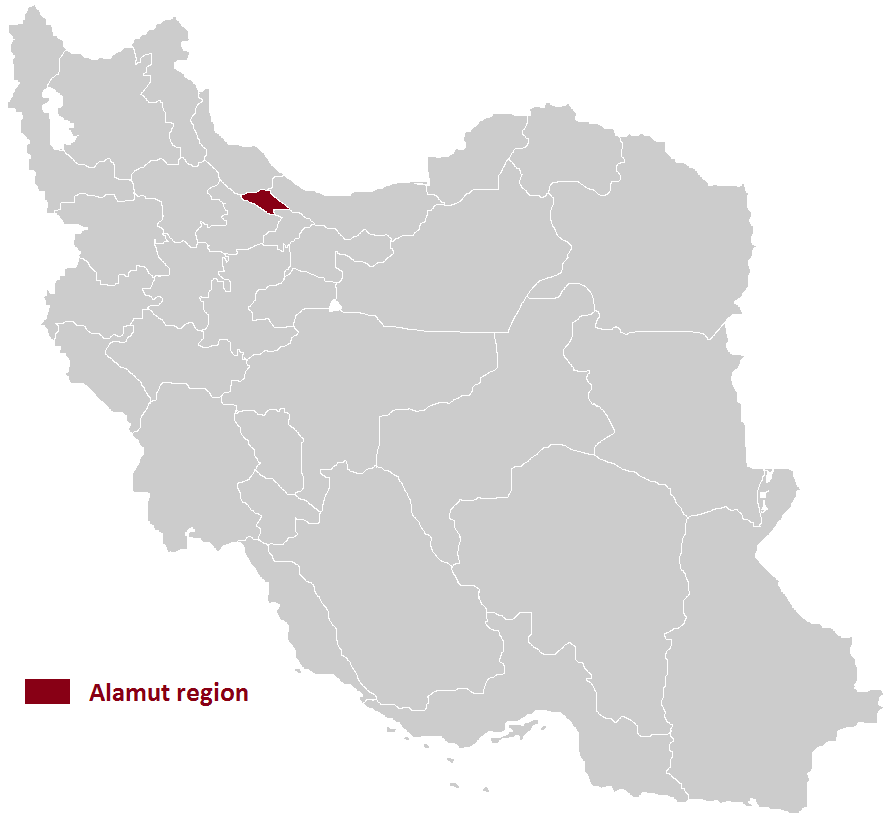|
Ahmad Ibn Nizam Al-Mulk
Ḍiyaʾ al-Mulk Aḥmad ibn Niẓām al-Mulk (), was a Persian vizier of the Seljuq Empire and then the Abbasid Caliphate. He was the son of Nizam al-Mulk, one of the most famous viziers of the Seljuq Empire. Biography Ahmad was born in Balkh, he was the son of Nizam al-Mulk, and a Georgian princess, who was the niece or daughter of Bagrat III of Georgia. During the lifetime of his father, Ahmad lived in Hamadan and Isfahan, and continued to do so in a few years after his father's death. In 1106/1107, he went to the court of Sultan Muhammad I to file a complaint against the rais (head) of Hamadan. When Ahmad arrived to the court, Muhammad I appointed him as his vizier, replacing Sa'd al-Mulk Abu'l-Mahasen Abi who had been recently executed on suspicion of heresy. The appointment was due mainly to the reputation of his Ahmad's father. He was then given various titles which his father held (Qewam al-din, Sadr al-Islam and Nizam al-Mulk). Ahmad was vizier for four years in which ... [...More Info...] [...Related Items...] OR: [Wikipedia] [Google] [Baidu] |
Balkh
Balkh is a town in the Balkh Province of Afghanistan. It is located approximately to the northwest of the provincial capital city Mazar-i-Sharif and approximately to the south of the Amu Darya and the Afghanistan–Uzbekistan border. In 2021–2022, the National Statistics and Information Authority reported that the town had 138,594 residents. Listed as the List of cities in Afghanistan, eighth largest settlement in the country, unofficial 2024 estimates set its population at around 114,883 people. Historically, the site of present-day Balkh was held in considerably high regard due to its religious and political significance in Ariana. A hub of Zoroastrianism and Buddhism, the ancient city was also known to the Ancient Iran, Persians as Zariaspa and to the Ancient Greece, Greeks as Bactra, giving its name to Bactria. As such, it was famously known as the capital of Bactria or Tokharistan. The Italian explorer and writer Marco Polo described Balkh as "a noble city and a great ... [...More Info...] [...Related Items...] OR: [Wikipedia] [Google] [Baidu] |
Isfahan
Isfahan or Esfahan ( ) is a city in the Central District (Isfahan County), Central District of Isfahan County, Isfahan province, Iran. It is the capital of the province, the county, and the district. It is located south of Tehran. The city has a population of approximately 2,220,000, making it the third-most populous city in Iran, after Tehran and Mashhad, and the second-largest metropolitan area. Isfahan is located at the intersection of the two principal routes that traverse Iran, north–south and east–west. Isfahan flourished between the 9th and 18th centuries. Under the Safavid Iran, Safavid Empire, Isfahan became the capital of Iran, for the second time in its history, under Abbas the Great. It is known for its Persian architecture, Persian–Islamic architecture, Muslim architecture, grand boulevards, covered bridges, palaces, tiled mosques, and minarets. Isfahan also has many historical buildings, monuments, paintings, and artifacts. The fame of Isfahan led to the ... [...More Info...] [...Related Items...] OR: [Wikipedia] [Google] [Baidu] |
Malik Shah I
Malik-Shah I (, ) was the third sultan of the Seljuk Empire from 1072 to 1092, under whom the sultanate reached the zenith of its power and influence. During his youth, he spent his time participating in the campaigns of his father Alp Arslan, along with the latter's vizier Nizam al-Mulk. During one such campaign in 1072, Alp Arslan was fatally wounded and died only a few days later. After that, Malik-Shah was crowned as the new sultan of the empire, but the succession was contested by his uncle Qavurt. Although Malik-Shah was the nominal head of the Seljuk state, Nizam al-Mulk held near absolute power during his reign. Malik-Shah spent the rest of his reign waging war against the Karakhanids to the east and establishing order in the Caucasus. The cause of Malik-Shah's death remains under dispute to this day; according to some scholars, he was poisoned by Abbasid caliph al-Muqtadi, while others say that he was poisoned by the supporters of Nizam al-Mulk. Etymology Although ... [...More Info...] [...Related Items...] OR: [Wikipedia] [Google] [Baidu] |
Nezamiyeh
The Nezamiyeh () or Nizamiyyah () are a group of institutions of higher education established by Khwaja Nizam al-Mulk in the eleventh century in Iran. The name ''nizamiyyah'' derives from his name. Founded at the beginning of the Seljuk Empire, these Sunni Islam theological schools are considered to be the model of later Islamic universities, or schools. Nizamiyyah institutes were among the first well organized institutions of higher learning in the Muslim world. The quality of education was among the highest in the Islamic world, and they were even renowned in Europe. They were supported financially, politically, and spiritually by the royal establishment and the elite class. Some scholars have suggested that the establishment of the Nizamiyya madrasas was in fact an attempt to thwart the growing influence of another group of Muslims, the Ismailis, in the region. Indeed, Nizam al-Mulk devoted a significant section in his famous '' Siyasatnama (Books of Politics)'' to refuting ... [...More Info...] [...Related Items...] OR: [Wikipedia] [Google] [Baidu] |
Al-Mustarshid
Abu Mansur al-Faḍl ibn Ahmad al-Mustazhir (; 1092 – 29 August 1135) better known by his regnal name Al-Mustarshid Billah () was the Abbasid caliph in Baghdad from 1118 to 1135. He was son of his predecessor, caliph al-Mustazhir. He succeeded his father in the year 1118 as the Abbasid caliph. Biography Al-Mustarshid was born in 1092. He was son of Caliph Al-Mustazhir. His mother was a Slavic concubine named Lubanah. She was from Baghdad. His was named Al-Fadl by his father. His full name was Al-Fadl ibn Ahmad al-Mustazhir and his Kunya was ''Abu Mansur''. After the death of his father in 1118, he succeeded him as Caliph. He achieved more independence as a ruler while the Seljuk sultan Mahmud II was engaged in war in the East. In 1122, al-Mustarshid deposed and imprisoned his vizier Amid al-dawla Jalal al-Din Hasan ibn Ali. Mahmud II then imposed Ahmad ibn Nizam al-Mulk as al-Mustarshid's vizier. Ahmad later fought against the ''Mazyadid'' chief Dubays ibn Sadaqa. Ahmad ... [...More Info...] [...Related Items...] OR: [Wikipedia] [Google] [Baidu] |
Mahmud II Of Great Seljuq
Mughith al-Dunya wa'l-Din Mahmud bin Muhammad (b. 1104 – 11 September 1131) known as Mahmud II was the Seljuk sultan of Iraq from 1118–1131 following the death of his father Muhammad I Tapar. At the time Mahmud was fourteen, and ruled over Iraq and Persia. Biography During Mahmud's early reign, his vassal king Garshasp II, who was a favorite of his father Muhammad I, fell into disgrace. Slander about him spread to the court that made him lose confidence, and made Mahmud send a military force to Yazd where Garshasp was arrested and jailed in Jibal, while Yazd was granted to the royal cupbearer. Garshasp, however, escaped and returned to Yazd, where he requested protection from Mahmud's rival Ahmad Sanjar (Garshasp's wife was the sister of Ahmad). Garshasp urged Ahmad to invade the domains of Mahmud in Central Persia, and gave him information on how to march to Central Persia, and the ways to combat Mahmud. Ahmad accepted and advanced with an army to the west in 1119, where ... [...More Info...] [...Related Items...] OR: [Wikipedia] [Google] [Baidu] |
Anushirvan Ibn Khalid
Anushirvan ibn Khalid ibn Muhammad Kashani (), also known as Abu Nasr Sharaf al-Din, was a Persian statesman and historian, who served as the vizier of the Seljuq Empire and the Abbasid Caliphate. Anushirvan was born in 1066/7 at Ray; he belonged to a Twelver Shia family which had origins in Kashan. He was a treasurer and head of the Seljuq military during the reign of Sultan Muhammad I. Anushirvan was later succeeded by Shams al-Mulk Uthman as head of the Seljuq military. After this, Anushirvan went to Baghdad, where he later became head of the Seljuq military once again. He was shortly appointed by Mahmud II as his vizier in 1127, and remained in that office until 1128. Anushirvan served as the vizier of the Abbasid caliph al-Mustarshid from 1132 to 1134, and then briefly as the vizier of the new Seljuq Sultan Ghiyath ad-Din Mas'ud Ghiyath al-Dunya wa'l-Din Abu'l-Fath Mas'ud bin Muhammad ( 1107 – 10 October 1152) was the Seljuq Sultan of Iraq and western Persia in 1133� ... [...More Info...] [...Related Items...] OR: [Wikipedia] [Google] [Baidu] |
Alamut
Alamut () or Rudbar () is a region in Iran including western and eastern parts on the western edge of the Alborz (Elburz) range, between the dry and barren plain of Qazvin in the south and the densely forested slopes of the Mazandaran province in the north. Starting from Qazvin toward Alamut, passing through the first range of hills, curvatures, forms, are significant themes in nature's composition of this area. The famous Ismaili castle of Alamut and numerous others are in this area, which served as the heartland of the state founded by Hassan-i Sabbah. According to some sources, the majority of people in northern Qazvin (Alamut) are Tats who speak a dialect of the Tati language.گونههای زبانی تاتی، دونالد استیلو، ۱۹۸۱ However, other sources claim that the majority of people in Alamut are Mazanderani or Gilaks who speak a dialect of the Mazanderani language or Gilaki language. According to some linguists, the term ‘Tati’ was ... [...More Info...] [...Related Items...] OR: [Wikipedia] [Google] [Baidu] |
Nizari Ismaili State
The Nizari state (the Alamut state) was a Nizari Isma'ili Shia state founded by Hassan-i Sabbah after he took control of the Alamut Castle in 1090 AD, which marked the beginning of an era of Ismailism known as the "Alamut period". Their people were also known as the '' Assassins'' or ''Hashashins''. The state consisted of a nexus of strongholds throughout Persia and the Levant, with their territories being surrounded by huge swathes of hostile as well as crusader territory. It was formed as a result of a religious and political movement of the minority Nizari sect supported by the anti- Seljuk population. Being heavily outnumbered, the Nizaris resisted adversaries by employing strategic, self-sufficient fortresses and the use of unconventional tactics, notably assassination of important adversaries and psychological warfare. They also had a strong sense of community as well as total obedience to their leader. Despite being occupied with survival in their hostile environment ... [...More Info...] [...Related Items...] OR: [Wikipedia] [Google] [Baidu] |
Al-Mazeedi
The Banū Mazyad () or Mazyadids were an Arab dynasty following Shia Islam. They belonged to the clan of Nāshira of the tribe of Banū Asad. They ruled an autonomous emirate in the area around Kūfa and Hīt in central Iraq between c. 961 and c. 1160. Older sources sometimes mistakenly date the beginnings of Mazyadid rule to the early 11th century, but Ali ibn Mazyad's reign must be dated a half century earlier. The Banu Mazyad first acquired titles and subsidies from the Buyid emir Mu'izz al-Dawla in return for military services between 956 and 963. These included lands between Kūfa and Hīt. In 1012, Ali founded Ḥilla which would later become their capital.Moojan Momen, ''An Introduction to Shi'i Islam'' (Yale University Press, 1985). Originally a mere encampment, Ḥilla merged with the earlier settlement of Jami'ayn. Under Sadaqa I (1086–1108), a wall was built around the new city and it became the capital of Mazyadid power. The Mazyadids' chief rivals were the Uq ... [...More Info...] [...Related Items...] OR: [Wikipedia] [Google] [Baidu] |




